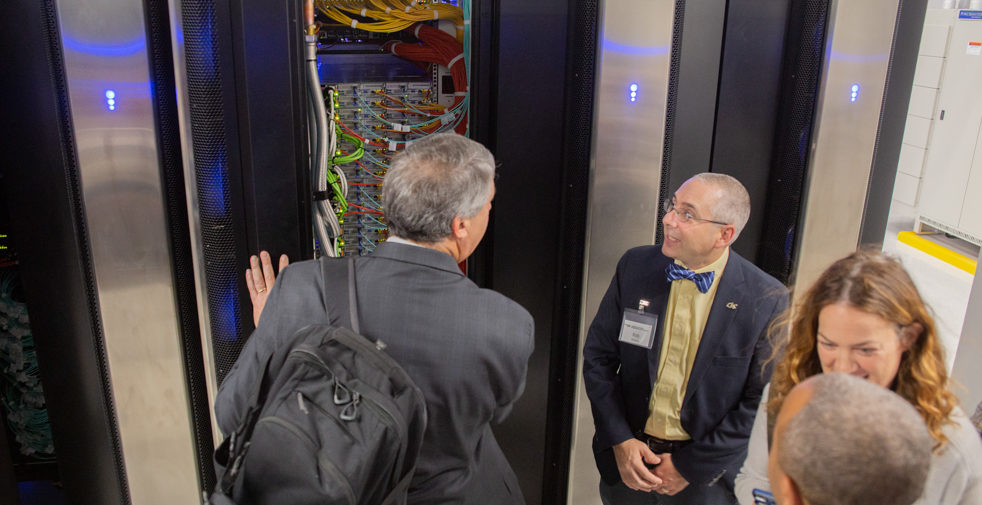A crowd of senior faculty gathered in the conference room on the bottom floor of CODA’s data center. The Tech Square building is white from floor to ceiling with multiple levels of security protecting the innovation within. CSE professor, interim-chair and the Institute for Data Engineering and Science (IDEaS) Director Srinivas Aluru stood at the front of the room with Paul Manno (Senior HPC Architect at PACE), Charles Isbell (Dean of the CoC), Neil Bright (Associate Director for Research Cyberinfrastructure at PACE), Chaouki Abdallah (Executive Vice President for Research at Tech) and Raheem Beyah (Vice President for Interdisciplinary Research) posing for a picture before the grand reveal.
Manno and Bright, staff at the Partnership for an Advanced Computing Environment (PACE), stepped away to allow Abdallah, Isbell, Aluru and Beyah to cut through the golden ribbon before them. As the ribbon fell, the room erupted in applause, and the dark panels behind the men lifted to reveal a window into the room where the Hive, Tech’s newest and greatest supercomputer, is located. “This is really an exciting day for us who have been working on the Hive supercomputer project,” said Aluru. “This is a demonstration of what we can do as a team at Georgia Tech.”
The Hive is a high-performance computer (HPC) specifically designed for data science research at Tech. The computer’s design was crafted by Tech faculty and staff from (IDEaS) and PACE. The $5 million computer was funded in part by the National Science Foundation (NSF) that footed 70% of the bill through the Major Research and Instrumentation Program grant; the remaining 30% was comprised of smaller grants from internal Tech offices.
The Hive computer is a heterogeneous system with over 11,500 codes and 100 trillion bytes of main memory making it “the most powerful supercomputer on campus,” said Aluru. Outside of the powerful computing software, the hardware is equally as impressive. Hive has specialty doors attached to the outside of the computer, complete with six fans each and circulation of cool water in pipes attached to the doors. Additionally, Manno mentioned that the computer contains over 2 kilometers of copper cables and 5 kilometers of fiber cables, making the system extremely large and complex.
“The university is trying to come up with a long term plan for high-performance computing, and this is a manifestation of our performance so far,” said Abdallah about the project that is a culmination of two years’ work and a cornerstone of “interdisciplinary collaboration.” The Hive, a product of interdisciplinary efforts, will aid in the completion of interdisciplinary study and be used by over 200 grad students, and more than 30 post-docs and data scientists here at Tech.
The Institute plans to move all computing services to CODA’s data center by the end of the school year, including OIT, to work alongside Hive as IDEaS’ data research goals are continually achieved.
